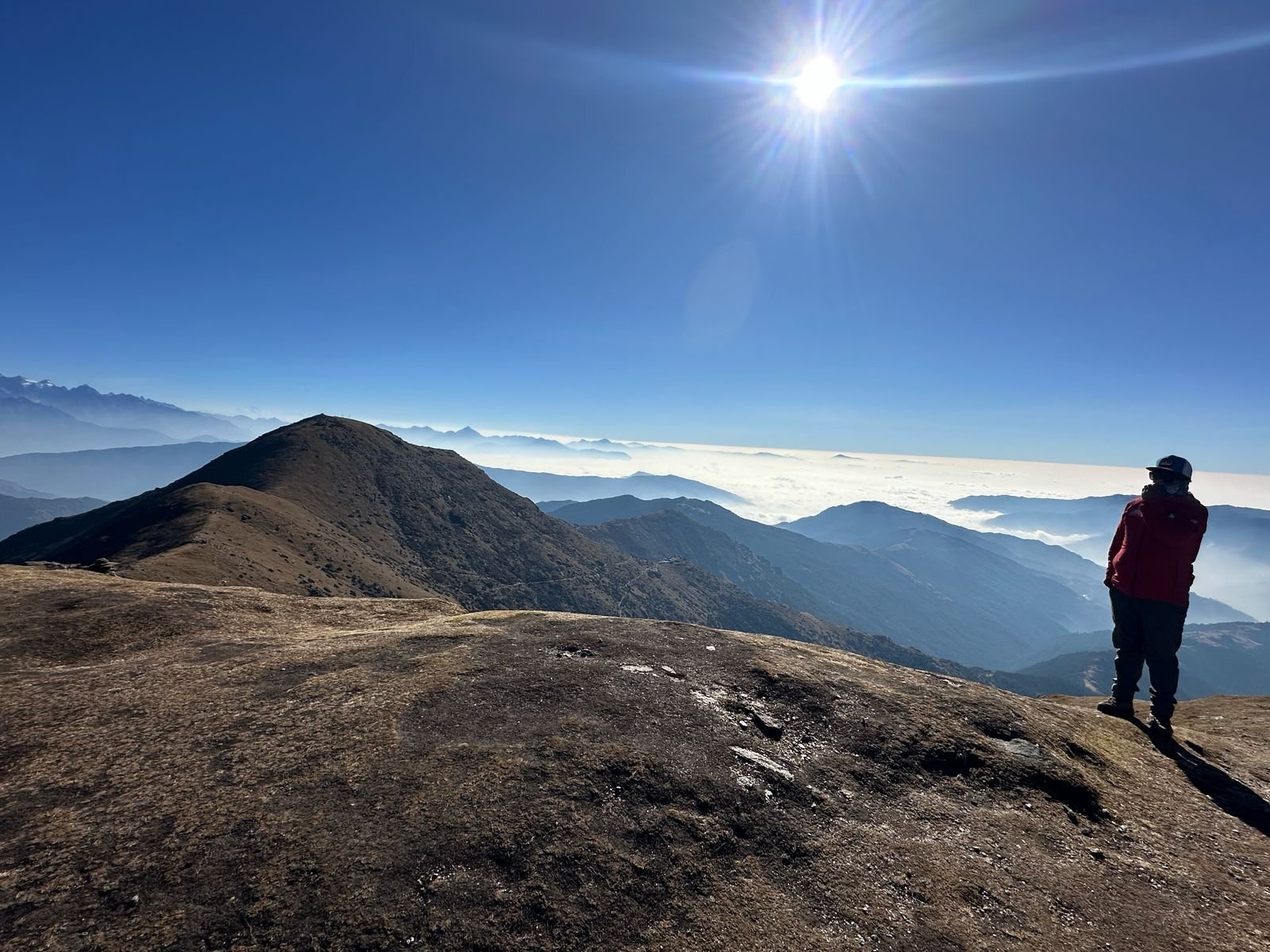Pikey Peak Trek: A Hidden Gem in the Lower Everest Region

Introduction
The Pikey Peak Trek is an off-the-beaten-path adventure in the Lower Everest Region. It offers breathtaking panoramic views of the Himalayas, including Mount Everest, Makalu, Kanchenjunga, Lhotse, and many other majestic peaks. Trekkers seeking an off-the-beaten-path adventure with stunning Himalayan views will find the Pikey Peak Trek a perfect choice. It serves as an excellent alternative to the more crowded routes. This trek is perfect for those looking to immerse themselves in the rich Sherpa culture, visit Buddhist monasteries, and explore diverse landscapes. It offers a peaceful alternative to the busier Everest Base Camp trek. In this blog, we will cover the essential information you need to know before embarking on the Pikey Peak Trek. This includes details on transportation, accommodation, food, difficulty level, history, and key points of interest.
History and Cultural Importance
The Pikey Peak Trek is full of cultural and historical significance. The Sherpa people, who have lived in the region for centuries, dominate it. The trek passes through several traditional Sherpa villages, where you can witness their unique lifestyle, ancient monasteries, and Buddhist stupas.
Pikey Peak: The local Sherpa people worship the Pikey deity, believed to have inspired the mountain’s name, representing the sky above nature. The mountain is a popular pilgrimage site for both Hindu and Buddhist believers, with locals visiting in large numbers to offer their prayers.
Buddhist Influence: The route is strewn with chortens (Buddhist shrines), prayer flags, and mani walls (stones featuring Buddhist mantras inscribed on them).
The region is also renowned for its connection to Sir Edmund Hillary, who once remarked that Pikey Peak offered the finest view of Everest he had ever had.
How to get to Pikey Peak
The Pikey Peak Trek can be completed in 5 to 8 days, depending on the start point and pace. The trek to Pikey Peak Trek commences in Kathmandu, the capital city of Nepal. From thereon, you have two main alternatives to reach the trailhead:
Starting Point: Kathmandu
1. By Road:
The easiest way of access to the trekking start point of Pikey Peak trek is by renting a personal jeep or by taking a public bus from Kathmandu to Dhap Bazaar (about 8 to 10 hours) or Jiri (7 to 8 hours). The road trip is long, yet it offers picturesque views of rural Nepal, passing through green hills, cultivated farmlands, and charming small villages
2. By Air:
Alternatively, the trekkers can take a short flight from Kathmandu to Phaplu for 35 minutes. From Phaplu, one can rent a jeep or trek to Dhap Bazaar (takes 2 to 3 hours).
Why Choose Pikey Peak Trek?
Pikey Peak Trek is teeming with natural beauty and culture. Sir Edmund Hillary himself had described it as providing the finest view of Everest he had ever seen. Here are some of the key points of interest:
1. Panoramic Views of Mountains:

– At Pikey Peak (4,065m), you will see some of the world’s tallest mountains, like Mount Everest, Kanchenjunga, Lhotse, Makalu, and Annapurna, in view.
– Sunrise and sunset views from Pikey Peak are simply breathtaking.
2. Sherpa Villages:
– Visit typical Sherpa villages like Junbesi, where one can interact with the locals and experience their unique traditions, food, and life.
– Exploring historic monasteries, including Thupten Chholing Monastery in Junbesi as well as other ancient monasteries along the trail.
3. Flora and Fauna:
– The trek takes you through beautiful rhododendron forests, which are especially vibrant during the spring season.
– Along the way, you may also spot wildlife such as Himalayan pheasants, musk deer, and variety of bird species.
4. Cultural Festivals:
– Should good fortune be smiling your way, you can watch the local festival like Mani Rimdu celebrated with mask dances and rituals.
5. Alternative Off-the-Between-Trail Experience:
In contrast to the more popular treks, Pikey Peak offers a quieter, more intimate experience, allowing you to connect deeply with both nature and local culture.
Best Time to Visit
The optimal time for the Pikey Peak Trek is in
- Spring (March to May) is the best time for the trek. The weather is good, rhododendrons are in bloom, and temperatures are pleasant.
- Autumn (September to November) offers stable weather and clear skies. This period follows the monsoon rain, making it ideal for trekking.
- Winter (December to February) is cold but it remains feasible for experienced trekkers who are well-prepared for the conditions. At higher elevations, you can expect snow, adding to the challenge.
- Monsoon (June to August) is less ideal and not recommended for trekking. The heavy rains create slippery trails, making the journey more challenging and less enjoyable.
Challenges and Preparation

Pikey Peak Trek is considered a moderate trek, making it suitable for both beginners with a reasonable level of fitness and experienced trekkers. Here’s what to expect:
• Duration: The trek typically takes 5 to 8 days, depending on your itinerary.
• Altitude: The highest point is Pikey Peak at 4,065 meters. Altitude sickness is less of a concern compared to higher treks, but proper acclimatization is still essential to ensure a safe and comfortable journey.
• Trail Conditions: The trail includes well-defined trails, with some steep up-and-down sections. The landscape varies from dense forests to rocky ridges.
• Physical Demand: The walk hours range from 4 to 7 hours a day. A good level of stamina is necessary, particularly for the ascent to Pikey Peak.
• Weather Conditions: Layered clothing, sturdy trekking boots, and good-quality gear are essential.
Facilities Along the Trek
The Pikey Peak Trek is a tea-house trek, meaning you will find basic accommodations and meals along the way. Although the facilities are not as developed as those on more popular treks like the Everest Base Camp or Annapurna Circuit, they are still sufficient for a comfortable journey.
Accommodation
• Tea Houses: These are simple lodges run by resident families. Accommodation is extremely simple, with twin beds and shared toilets. Blankets are provided, but bringing a sleeping bag for extra warmth and comfort is recommended.
Food
• Local Cuisine: The menu typically includes dal bhat (rice, lentils, and vegetables), noodles, soups, and Tibetan bread. Additionally, Western dishes such as pasta and pancakes are also available.
• Drinks: Tea, coffee, and soft drinks are easily found. It is advisable to avoid tap water; instead, use boiled or bottled water for safety.
Essential Tips for Trekkers
1. Permits: You will need a TIMS (Trekkers’ Information Management System) card, a Gaurishankar Conservation Area Permit, and a Sagarmatha National Park entry permit to trek in this area. These can be obtained in Kathmandu or Phaplu.
2. Packing List: Pack warm clothes and layers, good trekking boots, a sleeping bag, trekking poles, sunscreen, sunglass, a first-aid kit, personal medication, water purification tablets or bottles with filters, a headlamp, a power bank, and a good camera to capture the stunning scenery.
3. Guides and Porters: Although the trail is well marked, hiring a guide or porter can enhance your trip and support the local communities.
4. Altitude Awareness: Take your time to acclimatize and stay hydrated to avoid altitude sickness.
5. Respect Local Culture: Dress modestly, ask for permission before taking photos of people, and stick to local customs to show respect for the culture.
Responsible Trekking
- Respecting local customs and traditions during your trek is essential to ensure a positive and meaningful experience. This helps foster positive relationships with the communities you encounter and ensures a culturally respectful experience.
- To minimize environmental impact, avoid plastic waste by using reusable bottles. This helps protect the natural beauty of the region and promotes sustainable trekking practices.
- Support local businesses by staying in locally owned tea houses. This helps boost the local economy and provides an authentic experience of the region’s culture.
Conclusion
The Pikey Peak Trek is a hidden gem offering a peaceful trekking experience. It is the best alternative to the crowded trails of the Everest region. It combines nature, culture, and adventure at its best. Whether you are a beginner or an experienced trekker, this trek provides a short yet fulfilling adventure, catering to all levels of experience. It is the perfect alternative for those seeking a rewarding experience. With its easy accessibility and moderate difficulty, Pikey Peak is an excellent choice for trekkers. Its breathtaking landscape makes Pikey Peak an ideal destination for trekkers. It offers a unique opportunity to explore the Himalayas away from the crowded tourist paths.
If you want to experience Nepal’s unspoiled beauty and peaceful surroundings, the Pikey Peak Trek is a great choice. This trek offers a serene and authentic Himalayan adventure.
So pack your bags, lace up your boots, and get ready to discover one of Nepal’s best-kept secrets!







